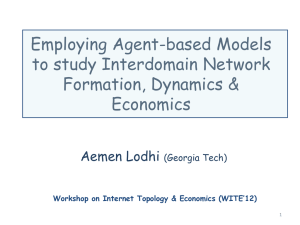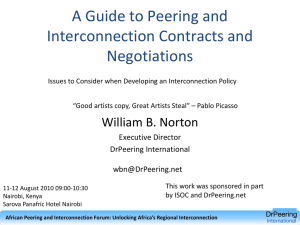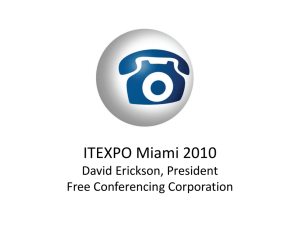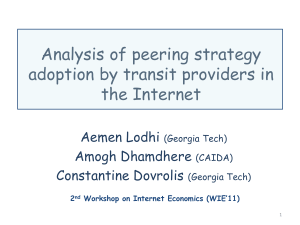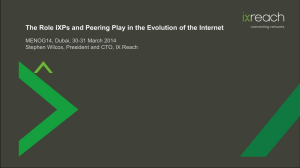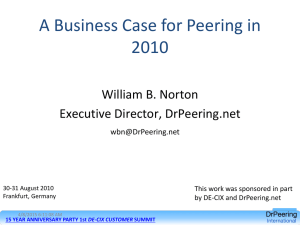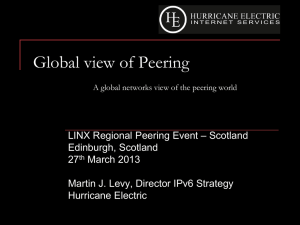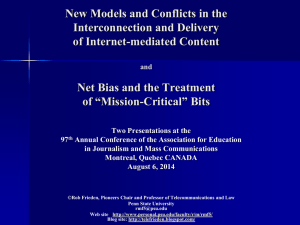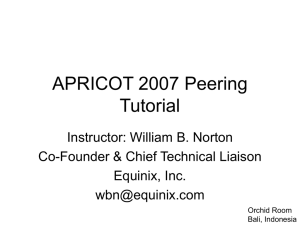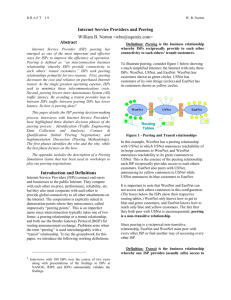The History of Peering
advertisement
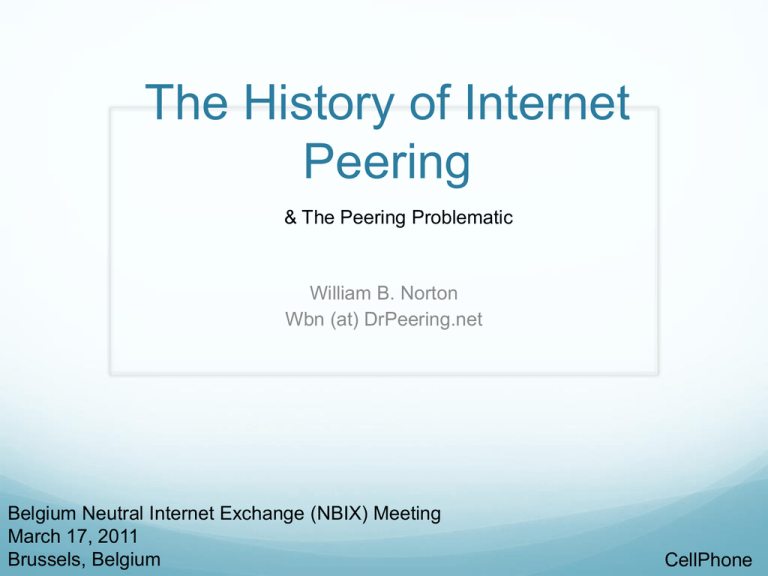
The History of Internet Peering & The Peering Problematic William B. Norton Wbn (at) DrPeering.net Belgium Neutral Internet Exchange (NBIX) Meeting March 17, 2011 Brussels, Belgium CellPhone William B. Norton NSFNET / NANOG Chair Equinix, 1998-2008, Co-Founder & Chief Technical Liaison DrPeering, Founder Ask.DrPeering.net – DECIX Newsletter Consulting – GLG Expert Network, Peering Workshops Peering White Papers The Peering White Papers… The Peering White Papers Process – 1000’s of conversations Mindset of the Peering Community Speak at Conferences Collect data Primary Research Results White Papers Web Pages Book-excerpts used in this preso Some quick definitions… Tonight Act I – Calculating the Value of the BNIX Act II – The Evolving Internet Peering Ecosystem Act III – The Peering Problematic Quick Definitions Internet Transit is a business relationship whereby an ISP provides (usually sells) access to the Global Internet. Internet Peering is a business relationship whereby two entities reciprocally provide access to each others customers. Internet Exchange Point (IX) is an Internet service that facilitates peering between two or more entities. Value of an Internet Exchange… Value of the BNIX VIX Value of the BNIX Value of the IX Surplus Value to Participants Cost of Peering p=44 participants Pvol=30Gbps Tp=5€/Mbps VBNIX=30,000*5€=150,000€/mo Cost of BNIX f(p,t,r) #participants Traffic Volume Routes Pcost =1000€ 44*1000€=44,000€/month Surplus 106,000€/month 2400€/participant Assumptions: Next best alternative for peered traffic is transit ValueRatio:150/44=3.4 5€ Transit (4€-10€ Transit Price range) PBE = 1000€/5€=200Mbps Ignoring cost of transport, colocation, equipment Averages used. (Traffic and pricing skewed by big peers.) The Evolving Internet Peering Ecosystem All about Context Why should we care about context? My Airplane Story NWA Flight DTW-LAX DelayCancel Rebook, go to gate 34 (short walk) On plane. Boarding disgruntles Flight attendant: “sit anywhere” Delayed… Palpable Anger What happened? What happened? Back at gate Flight was Cancelled “Room for 15-20 passengers” “Proceed in orderly fashion” “Will handle as many as we can” 154 people hauled Line special case override Mob Scene Get the yellers out of the line Aggression, pushing, shoving, many cops called Who is responsible? Airline vs. Passengers Show of hands ___ Airline 100% Passengers 0% responsible ___ Airline 90% Passengers 10% responsible ___ Airline 80% Passengers 20% responsible ___ Airline 70% Passengers 30% responsible : Does Context drive Behavior? The Peering Problematic Evolving Internet Peering context Positional power Predictable Behavior This is a talk about the future of peering Trajectory from the past Discussion Paper History of Internet Peering Contexts Access Powers • 2009 Fat Middle • 2000-2009 COMMERCIAL • 1998-2002 TRANSITION • 1994-1997 NSFNET • 1987-1994 ARPAnet 1st Peering: ARPANET 80’s USENET/BITNET/X.25 could not connect ARPAnet limited to gov’t & contractors CSNet-NSF project to connect all CS depts Spotlighted AUP problem Bureaucratic complexity Settlement of financial, admin, contract etc. Peering is “interconnection without explicit accounting or settlement” Source: http://www.interisle.net/sub/ISP%20Interconnection.pdf http://drpeering.net/AskDrPeering/blog/articles/Ask_DrPeering/Entries/2010/10/22_Origins_of_Internet_Peering.html NSFNET – ‘87-’94 Core Open Regional Techs Meetings NSF sponsored attachments GrowthTime to privatize NSFNET Transition – ’94-’96 Strong NANOG Chair model Interconnect a private matter Chair & commercial interests PacBell NAP AADS NAP MAE-East* Sprint NAP Commercial Internet – ’96-’98 Resale & Growth Little visibility/sharing NAPs=“Congestion Points” Private Peering Tier 1 Club Private Peering Migration AT&T Qwest Metro-Area Circuits Sprint Tier 1 Club NTT Level3 Verizon All settlement-free Peering Interconnections Tier 1 ISPs abandon NAPs Congestion at NAPs NAPs run by competitors Reduce complexity – fiber breaks less often than active electronics Full Mesh in each of 8 interconnect regions across the U.S. 2000-2001 Carrier Neutral Internet Exchange Points (PAIX/EQIX) Proved financially better if at least 5 Tier 1’s build in and do fiber cross connects Cost Savings of Exchange Point Interconnection over Circuit-based Interconnection Strategy $200,000 $100,000 $50,000 ($50,000) # of exchange partners 64 61 58 55 52 49 46 43 40 37 34 31 28 25 22 19 16 13 7 10 4 $0 1 Monthly Cost Savings $150,000 Commercial Internet Internet Growth Organic But evolved With structure: Basic Internet Peering Ecosystem Tier 1 ISPs have access to The entire Internet Region routing Table solely via their free peering Interconnects. They do not pay transit fees to reach any destination in their Internet Region. Revenue and traffic flows to T1s. Tier 2 ISPs are everyone else. Pay transit fees. Interested in peering around transit providers. Attend Peering Fora Fat Middle Peering ’00-’10 New Players @home bankrupt CDNs LSNSCP “Open” Peers : “Selective Peers” Tier 1 ISPs Transit $ $ $ $ Transit Transit P Cable Companies CDNs P P P Tier 2 ISPs P $ Peering decreases T1’s transit fees Growth increases at a faster rate Transit Large Scale Network Savvy Content Providers Transit Content Providers Key Trends: Transit Prices Decline & Video Emerges Video 2010: 40-50% Source: discussions with ISPs Video 2013: 80% Source: Cisco Captive Access Power Peering Tier 1 ISPs PP $ Transit $ $ $ $ PP Cable Companies $ $ Transit $ Transit PP CDNs P PP Tier 2 ISPs P $ Transit Large Scale Network Savvy Content Providers Transit Content Providers Captive Access Power Peering Comcast-Level 3 Disclaimer: The facts here have not been verified. This is for discussion purposes only. The Comcast-Level 3 – NetFlix situation is used because it is a very public example that illustrates the power positions Captive Access Power Peering Example Level3 broad business deal Fiber, transit, free peering (on-net), etc. 3 Ways to reach Comcast 1) Transit (AGLBXComcast) 2) Paid Peering (A->Comcast) 3) Peering (A->Comcast) w/vol & <2.5:1 $ T Video is highly asymmetric up to 30:1 Comcast peering ratio requirement<2.5:1 OTT Video requires high performance No alternative path to Comcast eyeballs but through Comcast (Captive customers) Global Crossing Level 3 $ TP Transit A All paths require Comcast Peering is direct, high performance Transit is subject to loss/latency TATA Global Crossing $ T $ T A PP $ Comcast $ PP Akamai millions of broadband homes If you are in the video distro biz you must buy paid peering from Comcast 1) NetFlix Application 2010 Level 3 $ NetFlix distributes Video via CDNs Massive growth O(100’sGbps) Great Service Peering $ T LimeLight Networks PP $ Transit Comcast $ PP NetFlix Akamai $ T NetFlix millions of broadband homes 2) Level3 Bids Cheaper Akamai loses T$ Comcast loses PP$ NetFlix Level 3 $ Level 3 freely peers the traffic Level 3 requests more interconnects Comcast says No – you pay like AKAM&LLNW Level 3 Acquiesces Access Power Peering Peering LimeLight Networks PP $ Transit Comcast $ PP NetFlix Akamai NetFlix millions of broadband homes Comcast says (in essence) “We have others paying us. Note: The Level3-Comcast relationship It wouldn’t be fair not to charge you as well” could be argued to not be a true peering relationship as there is asymmetric exchange. 3) Result & Observation v Comcast leverages peering to get $$ from all sides NetFlix No alternative to reach Comcast customers t Level 3 $ “Captive” Customers Can’t peer around them Can’t choose competitor Exploiting Market power position: Captive Market PP Peering Transit $ Where is this going? Is this the right model? LimeLight Networks PP $ Comcast $ PP Akamai $ NetFlix NetFlix millions of broadband homes Provocative Solution Ban Captive Access Paid Peering Access Networks with Market Power should only be allowed to sell in one direction (inbound or outbound). Broad Strokes Pick a direction and charge that direction Either charge the ingress or egress, but not both Why complain now? Tier 1 Model $ goes to Tier 1 ISPs Alternatives T1 Competitors are comparable alternative T2-T2 Peering bypass T1 Aligned group interest Leads to efficiency (n(n-1)) Leverages Performance (scope, scale, speed, reach) Leads to efficiency, lower transit in competitive market, peering applies downward pressure Power Access Model $ goes to Access No comparable alternative No Free Peering bypass Paid Peering required Benefits Comcast Content-Access efficiency Leverages Captive Market (customer base) Leads to efficiency if you pay access Too much power in hands of one player Does Context Drive Behavior? If Captive Access Paid Peering is allowed, what prevents paid peering price escalation? Acknowledgements Thanks to Frédéric Libotte (BNIX), Pierre Bruyère (BELNET), Jon Terreele (BELNET), Scott Landman (JetStream), and many anonymous discussions.
